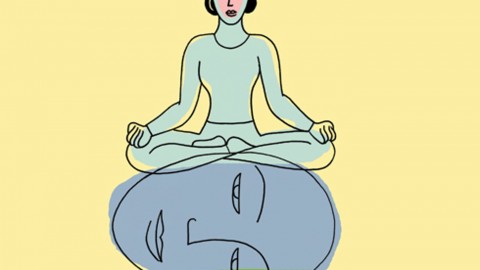The basic definition is, YOGA IS THE CESSATION OF MIND.
Patanjali is just mathematical. In a single sentence, NOW THE DISCIPLINE OF YOGA, he is finished with you. This is the only sentence that has been used for you. Now he takes it for granted that you are interested in yoga, not as a hope, but as a discipline, as a transformation right here and now. He proceeds to define: YOGA IS THE CESSATION OF MIND.
This is the definition of yoga, the best. In many ways yoga has been defined; there are many definitions. Some say yoga is the meeting of the mind with the divine; hence, it is called yoga – yoga means meeting, joining together. Some say that yoga means dropping the ego: ego is the barrier; the moment you drop the ego you are joined to the divine. You were already joined, only because of the ego it appeared that you were disjoined. And there are many, but Patanjali’s is the most scientific. He says, YOGA IS THE CESSATION OF MIND.
Yoga is the state of no-mind. The word “mind” covers all – your egos, your desires, your hopes, your philosophies, your religions, your scriptures. “Mind” covers all. Whatsoever you can think of is mind. All that is known, all that can be known, all that is knowable, is within mind. Cessation of the mind means cessation of the known, cessation of the knowable. It is a jump into the unknown. When there is no mind, you are in the unknown. Yoga is a jump into the unknown. It will not be right to say “unknown”; rather, “unknowable”.
What is the mind? What the mind is doing there? What is it? Ordinarily we think that the mind is something substantial there inside the head. Patanjali doesn’t agree – and no one who has ever known the insides of the mind will agree. Modern science also doesn’t agree. Mind is not something substantial inside the head. Mind is just a function, just an activity.
You walk and I say you are walking. What is walking? If you stop, where is walking? If you sit down, where has the walking gone? Walking is nothing substantial; it is an activity. So while you are sitting, no one can ask, “Where have you put your walking? Just now you were walking, so where has the walking gone?” You will laugh. You will say, “Walking is not something substantial, it is just an activity. I can walk. I can again walk and I can stop. It is an activity.”
Mind is also an activity, but because of the word “mind”, it appears as if something substantial is there. It is better to call it “minding” – just like “walking”. Mind means “minding”, mind means thinking. It is an activity.
Let me quote Bodhidharma.
He went to China, and the emperor of China went to see him. And the emperor said, “My mind is very uneasy, very disturbed. You are a great sage, and I have been waiting for you. Tell me what I should do to put my mind at peace.”
Bodhidharma said, “You don’t do anything. First you bring your mind to me.” The emperor could not follow, he said, “What do you mean?” He said, “Come in the morning at four o’clock when nobody is there. Come alone, and remember to bring your mind with you.”
The emperor couldn’t sleep the whole night. Many times he cancelled the whole idea: “This man seems to be mad. What does he mean, ‘Come with your mind; don’t forget?’” The man was so enchanting, so charismatic that he couldn’t cancel the appointment. As if a magnet was pulling him, at four o’clock he jumped out of the bed and said, “Whatsoever happens, I must go. This man may have something; his eyes say that he has something. Looks a little crazy, but still I must go and see what can happen.”
So he reached, and Bodhidharma was sitting with his big staff. He said, “So you have come? Where is your mind? Have you brought it or not?”
The emperor said, “You talk nonsense. When I am here my mind is here, and it is not something which I can forget somewhere. It is in me.” So Bodhidharma said, “Okay. So the first thing is decided – that the mind is within you.” The emperor said, “Okay, the mind is within me.” Bodhidharma said, “Now close your eyes and find out where it is. And if you can find out where it is, immediately indicate to me. I will put it at peace.”
So the emperor closed his eyes, tried and tried, looked and looked. The more he looked, the more he became aware there is no mind, mind is an activity. It is not something there so you can pinpoint it. But the moment he realized that it is not something, then the absurdity of his quest became exposed to himself. If it is not something, nothing can be done about it. If it is an activity, then don’t do the activity; that’s all. If it is like walking, don’t walk.
He opened his eyes. He bowed down to Bodhidharma and said, “There is no mind to be found.” Bodhidharma said, “Then I have put it at peace. And whenever you feel that you are uneasy, just look within, where that uneasiness is.” The very look is anti-mind, because look is not a thinking. And if you look intensely your whole energy becomes a look, and the same energy becomes movement and thinking.
YOGA IS THE CESSATION OF MIND.
This is Patanjali’s definition. When there is no mind, you are in yoga; when there is mind you are not in yoga. So you may do all the postures, but if the mind goes on functioning, if you go on thinking, you are not in yoga. Yoga is the state of no-mind. If you can be without the mind without doing any posture, you have become a perfect yogi. It has happened to many without doing any postures, and it has not happened to many who have been doing postures for many lives.
Because the basic thing to be understood is: when the activity of thinking is not there, you are there; when the activity of the mind is not there, when thoughts have disappeared, they are just like clouds, when they have disappeared, your being, just like the sky, is uncovered. It is always there – only covered with the clouds, covered with thoughts.
YOGA IS THE CESSATION OF MIND.
Try to understand. When Patanjali says, no-mind, cessation of mind, he means complete cessation. He will not allow you to make a japa, “Ram-Ram-Ram.” He will say that this is not cessation; you are using the mind. He will say, “Simply stop!” but you will ask, “How? How to simply stop?” The mind continues. Even if you sit, the mind continues. Even if you don’t – do, it goes on doing.
Patanjali says just look. Let mind go, let mind do whatsoever it is doing. You just look. You don’t interfere. You just be a witness, you just be an onlooker not concerned, as if the mind doesn’t belong to you, as if it is not your business, not your concern. Don’t be concerned! Just look and let the mind flow. It is flowing because of past momentum, because you have always helped it to flow. The activity has taken its own momentum, so it is flowing. You just don’t cooperate Look, and let the mind flow.
For many, many lives, million lives maybe, you have cooperated with it, you have helped it, you have given your energy to it. The river will flow awhile. If you don’t cooperate, if you just look unconcerned – Buddha’s word is indifference, upeksha: looking without any concern, just looking, not doing anything in any way – the mind will flow for a while and it will stop by itself When the momentum is lost, when the energy has flowed, the mind will stop. When the mind stops, you are in yoga: you have attained the discipline. This is the definition: YOGA IS THE CESSATION OF MIND.
THEN THE WITNESS IS ESTABLISHED IN ITSELF.
When the mind ceases, the witness is established in itself.
When you can simply look without being identified with the mind, without judging, without appreciating, condemning, without choosing – you simply look and the mind flows, a time comes when by itself, of itself, the mind stops.
When there is no mind, you are established in your witnessing. Then you have become a witness – just a seer-a drashta, a sakchhi. Then you are not a doer, then you are not a thinker. Then you are simply being pure being, purest of being. Then the witness is established in itself.
IN THE OTHER STATES THERE IS IDENTIFICATION WITH THE MODIFICATIONS OF THE MIND.
Except witnessing, in all states, you are identified with the mind. You become one with the flow of thoughts, you become one with the clouds: sometimes with the white cloud, sometimes with the black cloud, sometimes with a rain-filled cloud, sometimes with a vacant, empty cloud, but whatsoever, you become one with the thought, you become one with the cloud, and you miss your purity of the sky, the purity of space. You become clouded, and this clouding happens because you get identified, you become one.
A thought comes. You are hungry, and the thought flashes in the mind. The thought is simply that there is hunger, that the stomach is feeling hunger. Immediately you get identified; you say, “I am hungry.” The mind was just filled with a thought that hunger is there; you have become identified and you say, “I am hungry.” This is the identification.
Buddha also feels hunger, Patanjali also feels hunger, but Patanjali will never say that, “I am hungry.” He will say “The body is hungry”; he will say, “My stomach is feeling hungry”; he will say, “There is hunger. I am a witness. I have come to witness this thought, which has been flashed by the belly in the brain, that ‘I am hungry.’” The belly is hungry; Patanjali will remain a witness. You become identified, you become one with the thought.
THEN THE WITNESS IS ESTABLISHED IN ITSELF.
IN THE OTHER STATES THERE IS IDENTIFICATION WITH THE MODIFICATIONS OF THE MIND.
When the mind ceases, you are established in your witnessing self. In other states, except this, there are identifications. And all identifications constitute the samsar; they are the world. If you are in the identification, you are in the world, in misery. If you have transcended the identifications, you are liberated. You have become a siddha, you are in nirvana. You have transcended this world of misery and entered the world of bliss.
And that world is here and now-right now, this very moment! You need not wait for it a single moment even. Just become a witness of the mind, and you have entered. Get identified with the mind, and you have missed. This is the basic definition.
One has to achieve a state of no-mind: that is the goal.
Tags: Definition Of Yoga Identification With Mind Witness










